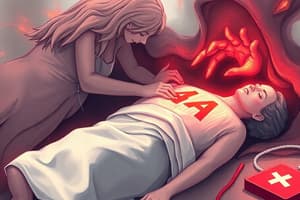Podcast
Questions and Answers
Death is a moment in time.
Death is a moment in time.
False (B)
What are the physical and chemical changes that occur during death?
What are the physical and chemical changes that occur during death?
Death is a series of physical and chemical changes that occur in the body.
What is the period of time immediately before somatic death called?
What is the period of time immediately before somatic death called?
Agonal period
Antemortem refers to the time after death.
Antemortem refers to the time after death.
Somatic death refers to the death of a specific cell or tissue.
Somatic death refers to the death of a specific cell or tissue.
What is the correct order of the process of death?
What is the correct order of the process of death?
What term describes a person who is actively dying?
What term describes a person who is actively dying?
The agonal period is always short.
The agonal period is always short.
What are the steps of the agonal period?
What are the steps of the agonal period?
Where does the word "agonal" come from?
Where does the word "agonal" come from?
The body can continue to function as a whole organism during the agonal period.
The body can continue to function as a whole organism during the agonal period.
What is the natural death of cells as they complete their cycles called?
What is the natural death of cells as they complete their cycles called?
What is the death of cells due to disease or injury called?
What is the death of cells due to disease or injury called?
Somatic death is the death of a single cell.
Somatic death is the death of a single cell.
The progression of somatic death is always the same.
The progression of somatic death is always the same.
What is the correct order of the progression of somatic death?
What is the correct order of the progression of somatic death?
Clinical death is irreversible.
Clinical death is irreversible.
Brain death is irreversible.
Brain death is irreversible.
What is the period in the death process where the organs and tissues begin to cease functioning?
What is the period in the death process where the organs and tissues begin to cease functioning?
Clinical death occurs when spontaneous respiration and heartbeat cease.
Clinical death occurs when spontaneous respiration and heartbeat cease.
What is the correct order of the brain's death during brain death?
What is the correct order of the brain's death during brain death?
What is the timeframe for brain and nervous system cells to live after death?
What is the timeframe for brain and nervous system cells to live after death?
What is the timeframe for muscle cells to live after death?
What is the timeframe for muscle cells to live after death?
What is the timeframe for cornea cells to live after death?
What is the timeframe for cornea cells to live after death?
What is the timeframe for blood cells to live after death?
What is the timeframe for blood cells to live after death?
Which of these is NOT a sign of death?
Which of these is NOT a sign of death?
The changes that occur during the death process do not influence the embalmer's procedures.
The changes that occur during the death process do not influence the embalmer's procedures.
What are some reasons why embalmers are more likely to encounter cases with extended agonal periods?
What are some reasons why embalmers are more likely to encounter cases with extended agonal periods?
Agonal algor is an increase in body temperature.
Agonal algor is an increase in body temperature.
What is the medical term meaning "cold or chill"?
What is the medical term meaning "cold or chill"?
What is the circulatory change occurring before death that causes blood to settle to the dependent tissues?
What is the circulatory change occurring before death that causes blood to settle to the dependent tissues?
Agonal coagulation is related to the thinning of fluids in the body.
Agonal coagulation is related to the thinning of fluids in the body.
What is the term for the increase in size of capillaries during the agonal period?
What is the term for the increase in size of capillaries during the agonal period?
Agonal edema is a decrease in fluids in the tissues.
Agonal edema is a decrease in fluids in the tissues.
Agonal dehydration is a loss of moisture from the tissues and can occur at the same time as agonal edema.
Agonal dehydration is a loss of moisture from the tissues and can occur at the same time as agonal edema.
What are some reasons for the movement of microorganisms during the agonal period?
What are some reasons for the movement of microorganisms during the agonal period?
It is essential to embalm a body as soon as possible after death to prevent postmortem changes.
It is essential to embalm a body as soon as possible after death to prevent postmortem changes.
Postmortem changes are only chemical in nature.
Postmortem changes are only chemical in nature.
What is a postmortem physical change?
What is a postmortem physical change?
Postmortem physical changes create chemical by-products.
Postmortem physical changes create chemical by-products.
What are some examples of postmortem physical changes?
What are some examples of postmortem physical changes?
What is the term for the postmortem cooling of the body to the surrounding temperature?
What is the term for the postmortem cooling of the body to the surrounding temperature?
The rate of algor mortis is the same for all individuals
The rate of algor mortis is the same for all individuals
Infants cool faster than adults because they have a lower ratio of surface area to body mass.
Infants cool faster than adults because they have a lower ratio of surface area to body mass.
A body with an elevated temperature at death will cool faster than a body with a normal temperature.
A body with an elevated temperature at death will cool faster than a body with a normal temperature.
How does refrigeration affect the body?
How does refrigeration affect the body?
Refrigeration is a completely effective way to prevent postmortem changes.
Refrigeration is a completely effective way to prevent postmortem changes.
Body coverings can accelerate the rate of heat loss.
Body coverings can accelerate the rate of heat loss.
A body submerged in 70-degree water cools faster than a body in 70-degree air.
A body submerged in 70-degree water cools faster than a body in 70-degree air.
What is the settling of blood and other fluids to the dependent portions of the body called?
What is the settling of blood and other fluids to the dependent portions of the body called?
Where does contact pallor occur?
Where does contact pallor occur?
Heat and certain medications can thin the blood, speeding up hypostasis.
Heat and certain medications can thin the blood, speeding up hypostasis.
Liver mortis is the result of hypostasis.
Liver mortis is the result of hypostasis.
Livor mortis is an extravascular discoloration.
Livor mortis is an extravascular discoloration.
When does livor mortis typically become visible?
When does livor mortis typically become visible?
Livor mortis can always be removed during the embalming process.
Livor mortis can always be removed during the embalming process.
Refrigeration can cause liver mortis to be more intense.
Refrigeration can cause liver mortis to be more intense.
What is the term for the dark, red-brown stripe that appears across the eyes when the eyelids are not closed?
What is the term for the dark, red-brown stripe that appears across the eyes when the eyelids are not closed?
In cases of carbon monoxide poisoning, liver mortis develops more slowly.
In cases of carbon monoxide poisoning, liver mortis develops more slowly.
A strong arterial solution can set liver mortis as a stain.
A strong arterial solution can set liver mortis as a stain.
Dehydration can only occur after death.
Dehydration can only occur after death.
What are the two basic factors involved in postmortem dehydration?
What are the two basic factors involved in postmortem dehydration?
Postmortem edema is the engorgement of tissues due to fluids flowing to lower areas.
Postmortem edema is the engorgement of tissues due to fluids flowing to lower areas.
It is beneficial to leave the body uncovered and exposed to air currents during the embalming process.
It is beneficial to leave the body uncovered and exposed to air currents during the embalming process.
What are some embalming considerations for dehydration?
What are some embalming considerations for dehydration?
What is the term for the thickness of a liquid?
What is the term for the thickness of a liquid?
Blood is entirely composed of a liquid portion.
Blood is entirely composed of a liquid portion.
Postmortem changes cease after embalming is complete.
Postmortem changes cease after embalming is complete.
Understanding postmortem changes is essential for successful embalming.
Understanding postmortem changes is essential for successful embalming.
Flashcards
What is Death?
What is Death?
Death is a process, not a moment in time. It involves a series of physical and chemical changes within the body.
What is the Agonal Period?
What is the Agonal Period?
The agonal period encompasses the time just before somatic death. It involves significant physiological changes like loss of heartbeat, respiration, and ultimately brain activity.
What does 'Antemortem' Mean?
What does 'Antemortem' Mean?
Antemortem refers to the time period before death.
What does 'Post Mortem' Mean?
What does 'Post Mortem' Mean?
Signup and view all the flashcards
What is Somatic Death?
What is Somatic Death?
Signup and view all the flashcards
What are the Stages of Death?
What are the Stages of Death?
Signup and view all the flashcards
What does 'Moribund' Mean?
What does 'Moribund' Mean?
Signup and view all the flashcards
What are Signs of Imminent Death?
What are Signs of Imminent Death?
Signup and view all the flashcards
When does Somatic Death Begin?
When does Somatic Death Begin?
Signup and view all the flashcards
What is Necrobiosis?
What is Necrobiosis?
Signup and view all the flashcards
What is Necrosis?
What is Necrosis?
Signup and view all the flashcards
What Happens After Somatic Death?
What Happens After Somatic Death?
Signup and view all the flashcards
What is Clinical Death?
What is Clinical Death?
Signup and view all the flashcards
What is Brain Death?
What is Brain Death?
Signup and view all the flashcards
What is Biological Death?
What is Biological Death?
Signup and view all the flashcards
What are the Signs of Death?
What are the Signs of Death?
Signup and view all the flashcards
What are Postmortem Changes in the Eye?
What are Postmortem Changes in the Eye?
Signup and view all the flashcards
What is Algor Mortis?
What is Algor Mortis?
Signup and view all the flashcards
What are the Factors Affecting Algor Mortis?
What are the Factors Affecting Algor Mortis?
Signup and view all the flashcards
What is Hypostasis?
What is Hypostasis?
Signup and view all the flashcards
What is Contact Pallor?
What is Contact Pallor?
Signup and view all the flashcards
What is Livor Mortis?
What is Livor Mortis?
Signup and view all the flashcards
What is Dehydration?
What is Dehydration?
Signup and view all the flashcards
What is Postmortem Edema?
What is Postmortem Edema?
Signup and view all the flashcards
What is Imbibition?
What is Imbibition?
Signup and view all the flashcards
What is Viscosity?
What is Viscosity?
Signup and view all the flashcards
Study Notes
Death Processes and Embalming Considerations
- Death is a process, not a moment in time, involving physical and chemical changes.
- The agonal period is the time immediately before somatic death.
- Somatic death is the death of the entire organism.
- Antemortem refers to the period before death, while postmortem refers to the period after death.
- Moribund describes a person actively dying, potentially over a short or long period.
- The agonal period involves loss of heartbeat, spontaneous breathing, and brain activity. Characteristic signs like a death rattle and struggle may appear if the period is prolonged.
- Somatic death follows the agonal period.
- Death progresses from agonal period to clinical death, brain death, biological death, and ultimately postmortem cellular death.
- Clinical death is a reversible phase (5-6 minutes); life can be restored within this time. If not, the process progresses to the next stage.
- Brain death occurs when respiration and heartbeat haven't been re-established within 5-6 minutes after the clinical death phase.
- Biological death, irreversible. Simple life processes in organs and tissues cease.
- Brain death involves the death of the cerebral cortex, midbrain, and then the brain stem. Brain and nervous system cells survive about 5 minutes after death, while muscle cells can survive for 3 hours and cornea cells for 6 hours.
- 8 signs of death include cessation of respiration and circulation, muscular flaccidity, eye changes, livor mortis, rigor mortis, algor mortis, and decomposition.
- Postmortem eye changes include clouding of the cornea, loss of conjunctiva luster, flattening of the eyeball, and dilated/unresponsive pupils.
- Embalming practices must consider changes in the body's composition and condition between death and embalming, as time between death and embalming impacts outcome.
Postmortem Physical Changes
- Algor mortis: Postmortem cooling of the body to the surrounding temperature. This rate is affected by factors like body surface area relative to body mass (corpulence), initial body temperature, and environment (e.g., covering, air vs. water).
- Hypostasis: Settling of blood and other fluids in dependent body parts due to gravity. This results in livor mortis.
- Contact pallor: Blood pooling is inhibited in areas pressing against a surface. The adjacent area may be discolored but the area in contact with the surface will stay pale.
- Livor mortis: Extravascular discoloration from hypostasis, appearing 0.5 to 2 hours after death. Can be red-brown patches that gradually take on a deeper reddish-blur appearance, and it can be influenced by blood volume and viscosity, or excessive bleeding.
- Tache noire: Dark, reddish-brown stripe across the eyes, mimicking trauma, from dehydration.
- Dehydration: Loss of moisture, either antemortem or postmortem, caused by surface evaporation or gravitation. This impacts blood viscosity. The embalming process and environment can intensify dehydration.
- Postmortem edema: Engorgement where liquids gather.
Factors Affecting Postmortem Changes
- Blood viscosity: Heat, medications, infections, and toxemia increase viscosity (thickening); refrigeration & blood thinners lower it. Higher viscosity slows down hypostasis.
- Agonal changes: Body temperature (algor mortis or agonal fever), blood circulation and changes in fluid content (hypostasis, edema, dehydration), and the movement of microorganisms (translocation) occur immediately before death. The embalmer should consider these factors for effective treatment.
Embalming Considerations
- Embalmers must consider the specific impacts of various postmortem changes in the body (e.g., algor mortis, hypostasis, livor mortis, dehydration, etc.).
- Time between death and embalming significantly affects the success of the process.
- Embalmers should always prioritize a slow, cautious approach to injection, even with advanced decomposition. Starting with a mild solution ensures better outcomes for all situations.
Studying That Suits You
Use AI to generate personalized quizzes and flashcards to suit your learning preferences.




